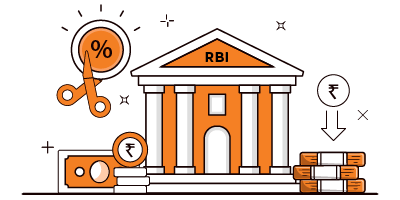The Reserve Bank of India in its bimonthly meeting in February 2019 has cut the benchmark policy rate by 25 basis points and is currently at 6.25%. With this rate cut, the central bank has changed its stance to ‘neutral’ from ‘calibrated tightening’.
But what is repo rate and how is it determined.
Firstly, RBI’s policy positioning depends upon the Consumer Price Index (CPI) or retail inflation of the country. RBI decides the repo rate, in line with the performance of CPI which has a major impact on purchasing and selling power.
Repo rate is the rate at which banks borrow money from the RBI. Eligible collateral is given by the bank for the borrowings and repo rate determines the percentage of interest that the bank needs to pay. When repo rates are high, it becomes difficult for the banks to borrow. As a result, they pass on the burden to their borrowers by increasing the price of loans. A hike in the repo rate means the RBI is trying to control the inflation. Similarly, when you see a rate cut, it means that the overall prices of products are under control in the economy.
The Reserve Bank of India has cut the benchmark policy rate by 25 basis points and is currently at 6.25%. With this rate cut, the central bank has changed its stance to ‘neutral’ from ‘calibrated tightening’. The effect of this rate change on companies, individuals and firms are given below.
For Companies
Lowered interest rate helps companies to borrow at a cheaper rate from banks. This gives an opportunity for the companies to make investments and work on their business expansions.
For Individuals
At the very first instance, when we hear there is a rate cut, we tend to celebrate that borrowings would become cheaper. Home loan, personal loan and vehicle loan interest rate may get eased, hence your EMIs will become cheaper. However, this isn’t very much true. This is because banks tightly control the benchmark rates to which floating interest rate loans are pegged. When there is a hike in RBI’s policy rates, the loan rates go up faster than expected. But, don’t float down with the same promptness. Real estate investment becomes more attractive with this rate cut and tax levies from the new budget.
Also, RBI had set the stage for the cascading benefit of reduced repo rates to the common man by banks earlier in December 2018. This is to ensure that banks regularize the home loan rates as per future repo rates and government bond yields. The final verdict is yet to be announced, and the banks are meeting with the RBI in the coming week.
Low Inflation
As per the new budget, it was announced that inflation was brought down to 4.6%, which is the lowest during the tenure of any government. When inflation is low, the prices of goods and services rise at a slower pace. Indian products become more competitive compared to international prices. This in return improves the country’s trade balance through a rise in exports.
Firms also prefer low inflation. This is because then it makes it very easier for them in making more investment and which reveals in future costs, prices and wages. If prices change at a slower rate, this gives ample time to firms in spending less time and energy on updating the prices of the goods.


















Show comments